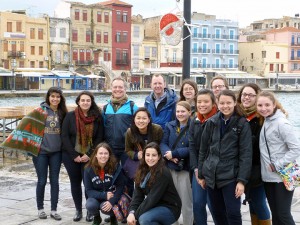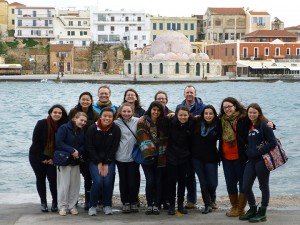We are excited to all be in Crete, with all of our luggage too… Our travels were complicated by the extreme weather in the US, but now all we have to fear is a little rain.
Students will be posting to this blog once or twice a day, describing our travels across Crete and what they are learning about the island’s history and culture. I suspect we might also see some images of the beautiful landscape and adorable animals.
Twelve students are enrolled in this traveling course “Crete through the Ages,” including majors in Classical Studies, History, Art, and Economics – to name a few. Over the next three weeks we will cover most of Crete, the largest island in the Aegean Sea, visiting a variety of sites, cities, and all four coast lines. Our studies will explore a long span of history, with special emphasis given to the art and architecture of the Minoan civilization (3000-1000 BCE). Our first day in Chania, however, has been dedicated to more recent periods since the city preserves wonderful buildings of the Byzantine, Venetian, and Ottoman periods.
The “Mosque of the Janissaries” was built immediately following the Turkish conquest of the city in 1645. It occupies a prime location in the city’s harbor, and today is used as an exhibition space. In addition, most of the city’s Venetian churches were converted into mosques for the new Muslim population. Although you can still find a few minarets preserved around town, most of these buildings now function as Greek Orthodox churches.


